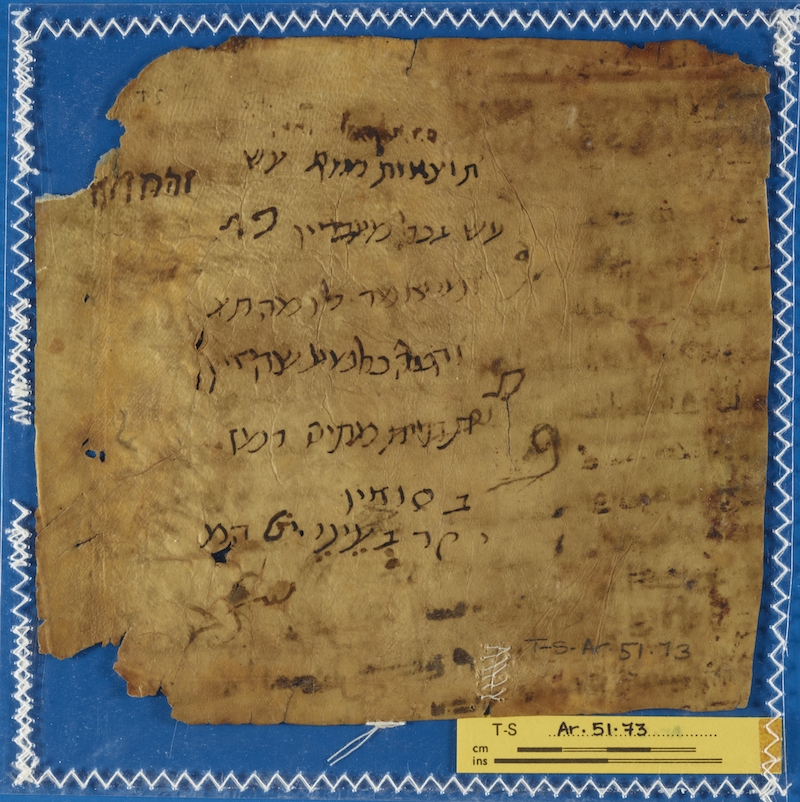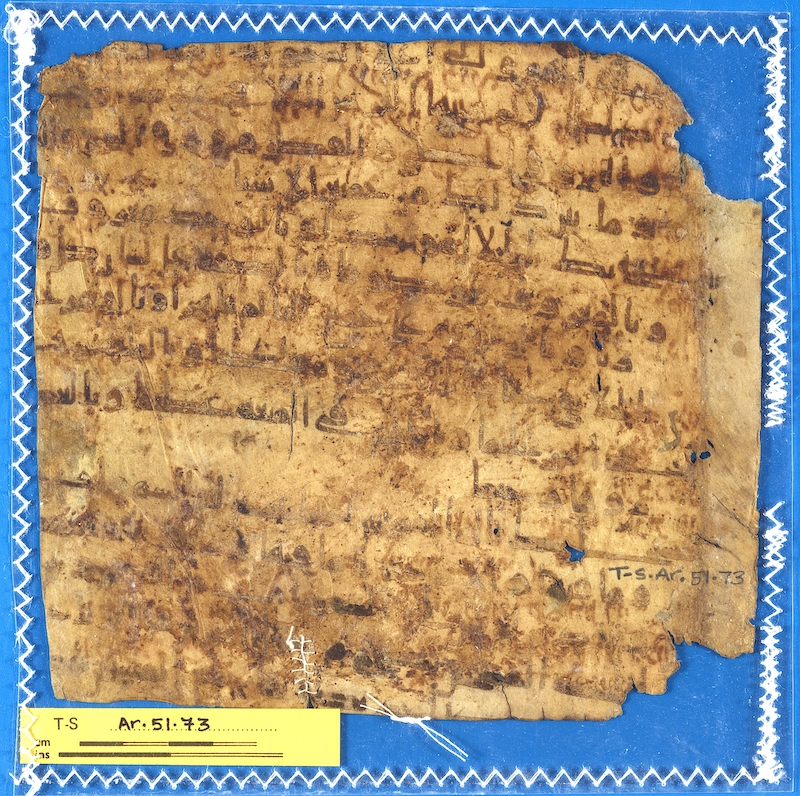Jewish Parchment, Muslim Prayer – Uncovering an Early Abbasid Palimpsest: T-S Ar.51.73
Sometimes it takes a while to identify a Genizah fragment. No one is an expert in all the languages, genres, and scripts that appear in Genizah collections, and even for experts, it is often difficult to decipher severely damaged manuscripts. The Genizah Research Unit has worked for almost five decades to catalogue the Taylor-Schechter Collection, but it is not uncommon to spend several hours identifying a single fragment, so many thousands have still never been read.
I first tried to identify T-S Ar.51.73 in 2018 while surveying Genizah collections for manuscripts of the Qurʾan.1 The fragment stood out because it has an old style of Arabic script that usually indicates Qurʾanic writing. Damage to the manuscript meant I could not immediately decipher the entire text, but it quickly became clear that this was not a section of the Qurʾan. It went on a list of unidentified classmarks I have labeled “Suspicious Fragments,” and then I promptly forgot about it.
That is, until March of 2021, when I suddenly remembered T-S Ar.51.73 while cataloguing another Arabic fragment.2 I searched up the manuscript again when I was supposed to be doing my job, and it seems that no one else identified it in the interim, so here we are.
T-S Ar.51.73 is a parchment fragment measuring 15.5 cm x 16.5 cm. It was originally part of a bifolium in a sewn quire booklet (notice the inner margin holes where the leaf was sewn), but only this one folio remains. Its small size suggests that the original codex was meant for private reading, rather than public use. The upper, lower, and outer margins have been cut off, but the extant fragment is still slightly wider than it is tall, suggesting that the original was in a “horizontal” format. Horizontal parchment manuscripts in the Genizah tend to be older than vertical parchment manuscripts, so this folio is probably from the earlier end of the Genizah period (ca. 10th/11th century).

Fig. 1: T-S Ar.51.73 recto
Unlike paper, parchment is made from animal skin, which means that manuscripts like T-S Ar.51.73 are (mostly) waterproof. This property allowed ancient scribes to wash the ink off of old folios that they no longer wanted to read. Combined with scraping to remove residual ink, this process created (mostly) blank surfaces to write new texts. Such manuscripts are called “palimpsests.” Some of the most famous Middle Eastern manuscripts are palimpsests created in this manner, including the Ṣanaʿāʾ Qurʾan, the Codex Sinaiticus Syriac Gospel, and the Genizah fragments of Aquila’s Greek translation of Kings.3 In what is probably a coincidence that we did not plan, the Cambridge University Library is currently running an exhibition on medieval palimpsests, including Genizah fragments, which you can tour online.4
T-S Ar.51.73 is indeed a palimpsest, with an Arabic undertext overwritten by Hebrew. The recto undertext is almost completely washed away, but a few Arabic letters are discernible near the bottom right corner. The rest of the page is several lines of rough Hebrew text comprising liturgical phrases related to death, possibly meant for a funeral. The parchment’s owner probably wrote these informal notes on the freshly washed leaf.
In contrast to the recto, the verso Arabic text was never erased. No Hebrew scribe has overwritten it, although there are a few remnants of Hebrew letters that seem to have rubbed off when T-S Ar.51.73 pressed against another fragment.

Fig. 2: T-S Ar.51.73 verso
The Arabic is difficult to decipher due to heavy staining and water damage. It is written in an early Islamic script style known as the “Early Abbasid” type E.I.5 Early Abbasid scripts are most common in manuscripts produced between the 8th and 10th centuries, during the era of the Abbasid Caliphate, and they fell out of use around the 10th or 11th century. This range correlates with the period that we expect for a horizontal parchment palimpsest created in Egypt. Early Abbasid scripts were also used almost exclusively by trained scribes to copy the Qurʾan, which makes T-S Ar.51.73 irregular, since it is not a Qurʾanic manuscript.
The exact identity of T-S Ar.51.73’s Arabic text is still uncertain since we can only read a few lines with confidence. The clearest portion (verso lines 5-10) reads:
Praise be to You, singular in exaltation, renowned in singularity, distinguished by renown, Lord by the distinction upon the tongue of every speaker, victorious over all the world in lordship, almighty over the created […] in victory, ruler by might, gentle in ruling with power, magnificent through gentleness in strength, and benevolently merciful through magnificence . . .
This section is part of a duʿāʾ, an Islamic prayer of supplication. It corresponds to similar prayers in several known texts, although it contains significant insertions and variations in vocabulary. The earliest close match that I have found is a section of a prayer in al-Durūʿ al-Wāqiya by al-Sayyid ibn Ṭāwūs (d. 1266). He records a duʿāʾ supposedly recited by the Caliph ʿAlī (d. 665) on the eleventh day of each month, and the final few lines are clearly related to this passage.6 Ibn Ṭāwūs was a Shiʿi jurist, and the Shiʿi Fatimid Caliphate ruled Egypt at the time when we expect T-S Ar.51.53 was copied, so the fragment may be part of a Shiʿi prayer book.
Other close matches come from the works of Zakariyyā al-Ansārī (d. 1520), a fifteenth-century Sunni Muslim judge who lived in Cairo, and his student, Ibn Ḥajar al-Haytamī (d. 1566).7 Ibn Ḥajar even attributes his version of the duʿāʾ to the Prophet Muḥammad via the ḥadīth scholar al-Tirmidhī (d. 892). Still, none of these authors record exactly the same prayer as the one in T-S Ar.51.73, so we can only conclude that these different texts are descended from a common ancestor in an earlier medieval duʿāʾ tradition. Variations of that tradition remained significant in Egypt even after T-S Ar.51.73 was retired in the Cairo Genizah.
We cannot be sure why a later scribe used this Arabic leaf for their Hebrew writing. Parchment was an expensive material in the medieval period, so it was not uncommon for people to reuse pieces of old manuscripts as a method of cost saving. The Hebrew writer may have purchased an old Arabic codex with the intention of removing individual leaves like T-S Ar.51.73 for this kind of reuse. It is also possible that they purchased just this single leaf, an option that may be supported by the fact that the margins have been cut down to a specific size that does not correspond to the Hebrew writing area. Alternatively – though less likely – the Jewish scribe may have already owned a Muslim prayer text for some other reason, perhaps for polemical writing or left over from personal conversion (and later reversion) between Judaism and Islam.
No matter who owned T-S Ar.51.73 or how it was used, we know that it ended its life in the Cairo Genizah. Its presence there reminds us that the Jews of medieval Fustat had regular contact with their Muslim neighbours, and if they wanted, they could also access Muslim religious texts. Some of these texts are preserved in Arabic Genizah fragments, even if they are not the first things that most people think of when considering a “Jewish” genizah. Many remain unidentified (or even misidentified), and only time will tell what else there is to uncover.
Footnotes
1 See Magdalen M. Connolly and Nick Posegay, “A Survey of Personal-Use Qurʾan Manuscripts Based on Fragments from the Cairo Genizah,” Journal of Qurʾanic Studies 23.2 (2021).
2 I believe it was a medical text about the various types of swellings. The mind works in mysterious ways.
3 The Aquila fragments are T-S 12.184 and T-S 20.50.
4 https://www.lib.cam.ac.uk/ghostwords and, from 24th May 2021, in person too.
5 E.I is related to the D-group styles but lacks a lower right-hand return on the letter alif. T-S Ar.51.73 is otherwise most similar to the D.IV style. See Alain George, The Rise of Islamic Calligraphy (London; Beirut: Saqi Books, 2010), 157–58; François Déroche, The Abbasid Tradition: Qurʾans of the 8th to 10th Centuries A.D., vol. 1, The Nasser D. Khalili Collection of Islamic Art (Khalili Collections, 1992).
6 al-Sayyid ibn Ṭāwūs, Al-Durūʿ al-Wāqiya (Qom: Yārān, 1993), 181, 199.
7 See Sulayman al-Jamal, ed., Ḥāshiyya Al-Jamal ʿalā al-Minhaj li-Shaykh al-Islām Zakariyyā al-Anṣārī, vol. IV (Beirut: Dār al-Fikr, 2006), 27–29; Ibn Ḥajar al-Haytamī, Al-Fatāwī al-Kubrā al-Fiqhiyya ʿalā Madhhab al-Imām al-Shāfiʿī, vol. I (Beirut: Dār al-Kutub al-ʿIlmiyya, 2018), 397.
Cite this article
Posegay, N. (2021). Jewish Parchment, Muslim Prayer – Uncovering an Early Abbasid Palimpsest: T-S Ar.51.73. [Genizah Research Unit, Fragment of the Month, June 2021]. https://doi.org/10.17863/CAM.82610
If you enjoyed this Fragment of the Month, you can find others here.
Contact us: genizah@lib.cam.ac.uk
The manuscripts in this article are part of the Cairo Genizah Collection in Cambridge University Library. To see more items from this collection visit: https://cudl.lib.cam.ac.uk/
